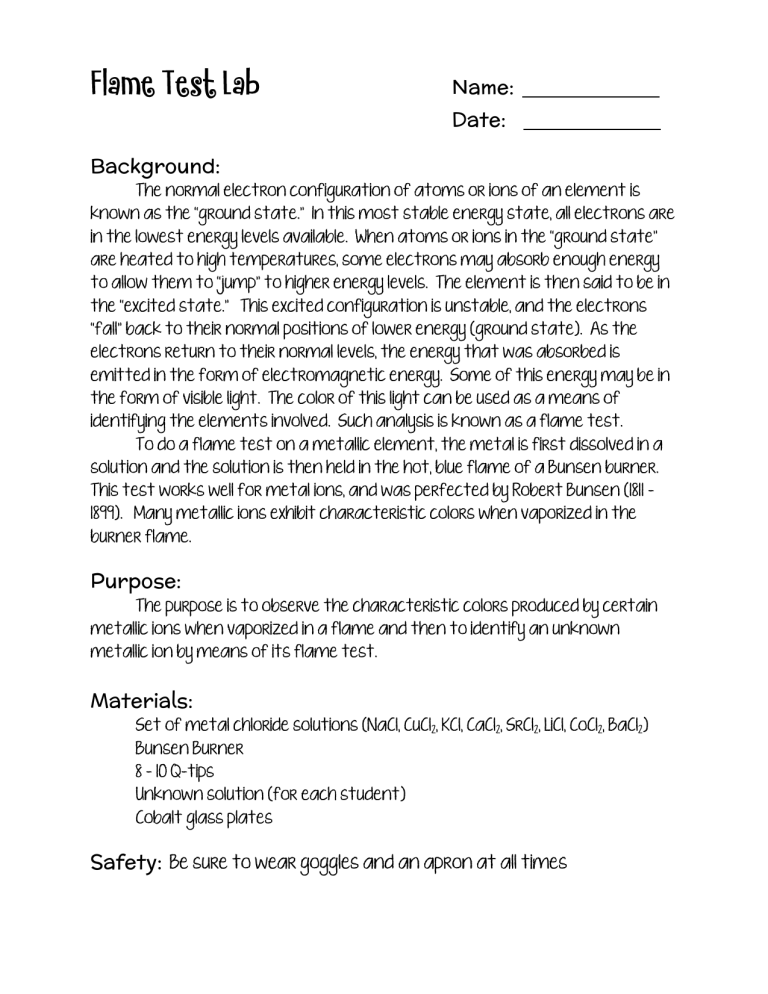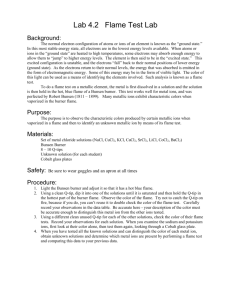
Name: Date: Background: The normal electron configuration of atoms or ions of an element is known as the “ground state.” In this most stable energy state, all electrons are in the lowest energy levels available. When atoms or ions in the “ground state” are heated to high temperatures, some electrons may absorb enough energy to allow them to “jump” to higher energy levels. The element is then said to be in the “excited state.” This excited configuration is unstable, and the electrons “fall” back to their normal positions of lower energy (ground state). As the electrons return to their normal levels, the energy that was absorbed is emitted in the form of electromagnetic energy. Some of this energy may be in the form of visible light. The color of this light can be used as a means of identifying the elements involved. Such analysis is known as a flame test. To do a flame test on a metallic element, the metal is first dissolved in a solution and the solution is then held in the hot, blue flame of a Bunsen burner. This test works well for metal ions, and was perfected by Robert Bunsen (1811 – 1899). Many metallic ions exhibit characteristic colors when vaporized in the burner flame. Purpose: The purpose is to observe the characteristic colors produced by certain metallic ions when vaporized in a flame and then to identify an unknown metallic ion by means of its flame test. Materials: Set of metal chloride solutions (NaCl, CuCl2, KCl, CaCl2, SrCl2, LiCl, CoCl2, BaCl2) Bunsen Burner 8 – 10 Q-tips Unknown solution (for each student) Cobalt glass plates Safety: Be sure to wear goggles and an apron at all times Procedure: 1. Light the Bunsen burner and adjust it so that it has a hot blue flame. 2. Using a clean Q-tip, dip it into one of the solutions until it is saturated and then hold the Q-tip in the hottest part of the burner flame. Observe the color of the flame. Try not to catch the Q-tip on fire, because if you do, you can’t reuse it to double check the color of the flame test. Carefully record your observations in the data table. Be accurate here - your description of the color must be accurate enough to distinguish this metal ion from the other ions tested. 3. Using a different clean unused Q-tip for each of the other solutions, check the color of their flame tests. Record your observations for each solution. When you examine the sodium and potassium ions, first look at their color alone, then test them again, looking through a Cobalt glass plate. 4. When you have tested all the known solutions and can distinguish the color of each metal ion, obtain unknown solutions and determine which metal ions are present by performing a flame test and comparing this data to your previous data. Name:________________________________ Mark ____/18____ Data table: Metal ion Date ___________ /8 Color of Flame Sodium Lithium Strontium Calcium Barium Potassium Copper Cobalt sodium (cobalt glass) potassium (cobalt glass) sodium and potassium sodium and potassium (cobalt glass) Unknown # ____ Unknown # ____ Based on your observations, identify the two unknowns you examined: Unknown # _____ is ________________________________ Unknown # _____ is ________________________________ Questions: Use complete sentences to answer each of the following: 1. State at least three problems that may be involved when using flame tests for identification purposes. ( 3 marks) 2. Which ions produce similar colors in the flame tests? (2 marks) 3. What purpose did the cobalt glass serve? (2 marks) 4. Explain how the colors observed in the flame tests are produced. (3 marks)





